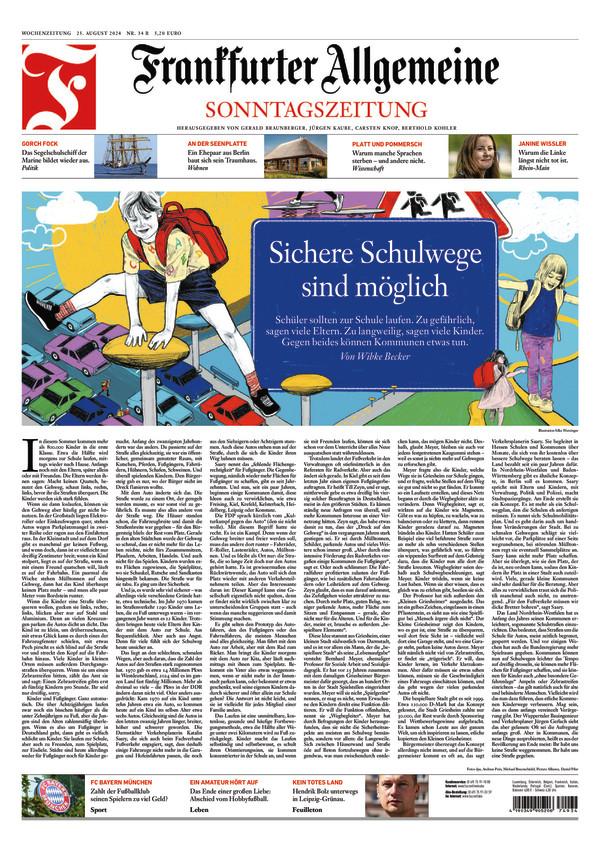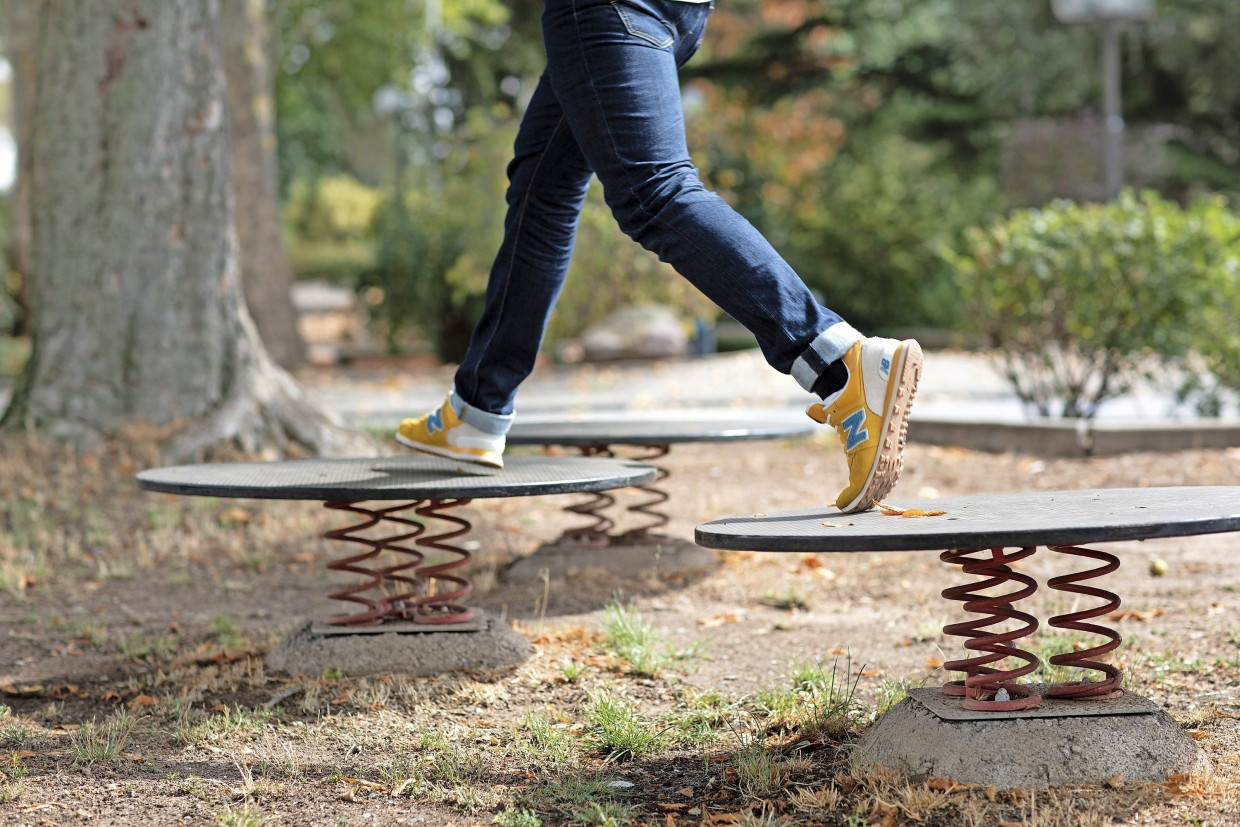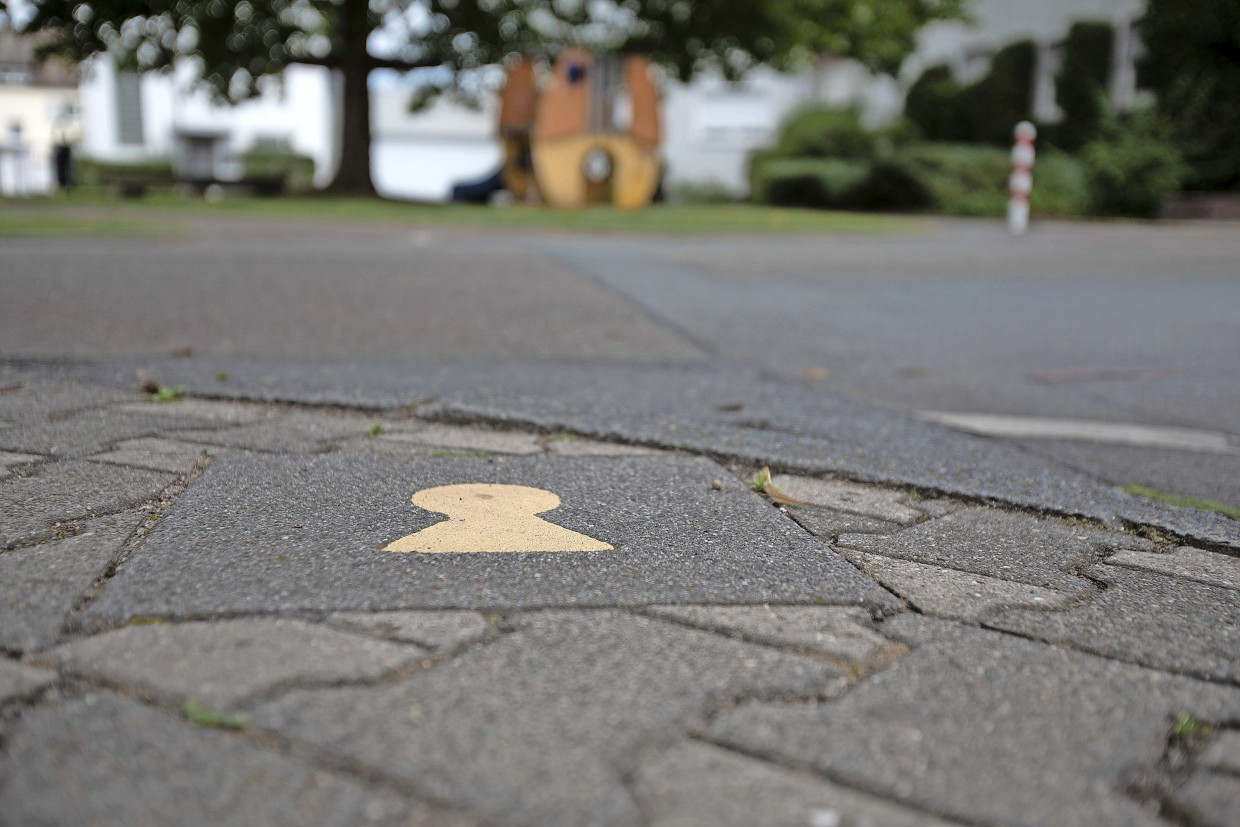Wenn sie dann loslaufen, können sie den Gehweg aber häufig gar nicht benutzen. In der Großstadt liegen Elektroroller oder Einkaufswagen quer, stehen Autos wegen Parkplatzmangel in zweiter Reihe oder ragen aus den Einfahrten raus. In der Kleinstadt und auf dem Dorf gibt es manchmal gar keinen Fußweg, und wenn doch, dann ist er vielleicht nur dreißig Zentimeter breit; wenn ein Kind stolpert, liegt es auf der Straße, wenn es mit einem Freund quatschen will, läuft es auf der Fahrbahn. Ein paarmal die Woche stehen Mülltonnen auf dem Gehweg, dann hat das Kind überhaupt keinen Platz mehr – und muss alle paar Meter vom Bordstein runter.
Wenn die Kinder eine Straße überqueren wollen, gucken sie links, rechts, links, blicken aber nur auf Stahl und Aluminium. Denn an vielen Kreuzungen parken die Autos dicht an dicht. Das Kind ist zu klein, um drüberzuschauen, mit etwas Glück kann es durch eines der Fahrzeugfenster schielen, mit etwas Pech pirscht es sich blind auf die Straße vor und streckt den Kopf auf die Fahrbahn hinaus. Viele Kinder in kleinen Orten müssen außerdem Durchgangsstraßen überqueren. Wenn sie um einen Zebrastreifen bitten, zählt das Amt sie und sagt: Einen Zebrastreifen gibts erst ab fünfzig Kindern pro Stunde. Ihr seid nur dreißig, sorry.
Städte sind nicht für Fußgänger gemacht
Kinder sind Fußgänger. Ganz automatisch. Die über Achtzigjährigen laufen zwar noch ein bisschen häufiger als die unter Zehnjährigen zu Fuß, aber die Jungen sind den Alten zahlenmäßig überlegen. Wenn es also um Fußgänger in Deutschland geht, dann geht es vielfach schlicht um Kinder. Sie laufen zur Schule, aber auch zu Freunden, zum Spielplatz, zur Eisdiele.
Städte sind heute allerdings weder für Fußgänger noch für Kinder gemacht. Anfang des zwanzigsten Jahrhunderts war das anders. Da passierte auf der Straße alles gleichzeitig, sie war ein öffentlicher, gemeinsam genutzter Raum, mit Kutschen, Pferden, Fußgängern, Fahrrädern, Hühnern, Schafen, Schweinen. Und überall spielenden Kindern. Den Bürgersteig gab es nur, wo der Bürger nicht im Dreck flanieren wollte.
Mit dem Auto änderte sich das. Die Straße wurde zu einem Ort, der geregelt werden musste, es war sonst viel zu gefährlich. Es musste also alles andere von der Straße weg. Die Häuser standen schon, die Fahrzeugbreite und damit die Straßenbreite war gegeben – für den Bürgersteig blieb: der Rest vom Platz.
Gerade in den alten Städtchen wurde der Gehweg so schmal, dass er nicht mehr für das Leben reichte, nicht fürs Zusammensitzen, Plaudern, Arbeiten, Handeln. Und auch nicht für das Spielen. Kindern wurden extra Flächen zugewiesen, die Spielplätze, wo sie Schaukel, Rutsche und Sandkasten hingestellt bekamen. Die Straße war für sie tabu. Es ging um ihre Sicherheit.

Dieser Text stammt aus der Frankfurter Allgemeinen Sonntagszeitung.
And yes, it has become much safer – but there are many different reasons for this, including technical ones. In 1970, 1,290 children who were walking were killed in traffic – last year, the number was 22 children. Despite this, many parents today drive their children to school. Out of convenience. But also out of fear. Because for many, the journey to school feels unsafe today.
This is due to the poor, narrow roads, but also because the number of cars on the roads has increased significantly. In 1970 there were around 14 million cars in West Germany, and by 2024 there will be almost fifty million in the whole country. More than three times as many – the cars in the GDR do not change that much. Or to put it another way: in 1970 there was about one car for every child under the age of ten, whereas today there are about six cars for every child of the same age.
At the same time, cars have become longer, wider, higher and heavier over the last twenty years. Katalin Saary, a traffic planner from Darmstadt who is also involved with the Pedestrian Association, says that as a result, some vehicles no longer fit into garages and driveways that date back to the 1970s or 1980s. These cars are now also parked on the street, through which children have to make their way.
Saary calls this a “lack of space equity” for pedestrians. The countermovement to create more space for pedestrians has been around for decades. And now, for a few years now, some municipalities have begun to implement these ideas, such as Freising, Kiel, Krefeld, Kelsterbach, Heidelberg, Leipzig and Konstanz.
It is a fight for space
The FDP recently spoke of a “cultural war against the car” (which it does not want). It was right with this term. It is a fight. Because if the sidewalk is to be wider and clearer, everything else has to go – bicycles, e-scooters, cargo bikes, cars, garbage cans. And the only place left is the street, which for so long belonged only to cars.
In a way, it is a reversal; the car should once again share space with other road users. But the interesting thing about it is that this fight cannot actually divide a society, because it does not really take place between clearly distinguishable groups – even if some people suggest that this is the case and use it to stir up sentiment.
There is rarely a prototype of a car driver, a pedestrian or a cyclist; most people are all of these things at the same time. You drive to work, but cycle to the bakery. You drive your children to daycare in the morning, but walk with them to the playground in the afternoon. So is something being taken away from a father if he can no longer park in the city center, or is something being given to him because his own children can go to school more safely and more often on their own? The answer is not easy, and it may be different for every member of a family.
Walking is a direct, free, healthy and frequent method of transport, with around half of all journeys under two kilometres being made on foot. Walking makes children independent and confident, it trains their sense of direction, they arrive at school more focused, and if they walk with friends they can chat about new things before class instead of during it.
More and more pedestrian representatives
Nevertheless, pedestrian traffic is often neglected in the administrative departments for bicycle traffic. But that is also changing. Kiel has had its own pedestrian representative since last year. His name is Till Zeyn, and he says that there are now around thirty to forty such representatives in Germany, mostly in the larger cities. New inquiries are constantly coming in from everywhere because more municipalities are interested in networking.
Zeyn says that this has something to do with the fact that the “pressure on the sidewalk” has increased significantly in recent years. It has always been high due to garbage cans, signs, parked cars and much more. “But by intensively promoting cycling, some municipalities have forgotten about pedestrians,” he says. Or even worse: cyclists are profiting at the expense of pedestrians, for example with additional bike racks or rental bikes on the sidewalk. Zeyn believes that the important thing now is to make walking more attractive again. With more space, good surfaces, fewer parked cars, more space to sit and relax – especially, but not only, for the elderly. And for the children, he believes, there also needs to be “playable elements”.
This idea comes from Griesheim, a small town southwest of Darmstadt, and it is above all one man who sees the “playable city” as his “life's work”: Bernhard Meyer, former professor of social work and social education. 25 years ago, together with the then mayor of Griesheim, he ensured that play areas were set up in a hundred places in the city.
Meyer doesn't want to call them “play equipment”; he doesn't like it when adults dictate a function to children. He wants to keep the function open and calls them “companions”. Meyer has found out through interviews with children that what they criticize most about the school route is not the safety aspects, but above all the boredom. Children don't like walking on boring concrete between the wall of a house and the street without anything to discover along the way. That's why, Meyer believes, they stop in front of every piece of chewing gum that has been crushed down – because otherwise there is nothing left to explore on the sidewalks.

Meyer asked the children which routes they took to school in Griesheim, and he asked them which parts of the route they liked and which parts they didn't like. He was able to create a walking network, and he began to actively change this network by using companions. Because companions, he says, act like magnets on the children. If there is something to jump, wobble, balance or climb, then children practically run towards it. Magnets therefore bring children together.
For example, if students had previously crossed a busy street in more than ten different places, which was dangerous, a bobbing surfboard on the sidewalk meant that the children now all crossed the street there. This is why companions on the way to school also speed up the journey, says Meyer. Children dawdle when they don't feel like it. But if they know that something is about to happen, they hurry up.
The professor also came up with the “Little Griesheimer”. It is a yellow sign set into a paving stone, it looks like a character in the game “Ludo”. The Little Griesheimer shows children where it is good to cross a street because there is a clear view – perhaps because there is a garage there, and where there is a garage, there are no cars parked in front of it.
Meyer doesn't think much of zebra crossings, he thinks they are “deceptive”. He wants children to learn how to cope with traffic. But to do that, they need to be able to see something, they need to be able to judge the speed of a vehicle, and that is often not possible because of the many parked cars.

The playable city has existed since 1999. The concept cost around 120,000 D-Marks, the town of Griesheim only paid 30,000, the rest was raised through sponsorship and competition winnings. People have come from all over the world to be inspired, and many have copied the Little Griesheimer.
However, mayors are not always convinced by the concept, and it is often the mayors who are the deciding factor, says traffic planner Saary. She spends months accompanying schools and municipalities in Hesse, who receive free advice from her on better routes to school – the state has been paying for this for a few years. There are similar concepts in North Rhine-Westphalia and Baden-Württemberg, and one is set to be introduced in Berlin.
Saary speaks to parents and children, to the administration, politicians and police, and takes walks around the city. At the end, she draws up a concept. It is more than a school route plan, which schools have to draw up anyway. It is called a school mobility plan. And it also involves tangible changes to the city. If the sidewalks are too narrow, she might suggest removing the parking spaces on one side; if the garbage cans are a nuisance, she might suggest creating collection points.
Saary cannot create more space. But she is thinking about how she can reorganize the space that is there so that children have their place in a city. Many communities, especially small ones, are very grateful for the advice. But sometimes politicians don't dare to implement everything; it would be too strenuous. “We have to do a lot to make pedestrian traffic possible,” says Saary.
At the beginning of the year, the state of North Rhine-Westphalia made it easier for its municipalities to set up so-called school streets. This means that streets around schools are closed to cars, usually for a limited period of time. And a few weeks ago, the federal government also gave more leeway. Municipalities can now more easily reduce the speed limit to 30 km/h on routes to school, they can create more space for pedestrians, and they can set up traffic lights or zebra crossings for children even “without a particularly dangerous situation” – this of course also applies to the elderly and disabled.
Perhaps this will lead to a number of municipalities improving children's paths. There may be some initial annoyance. But Wuppertal civil engineer and traffic planner Jürgen Gerlach is relaxed about it: there is often a lot of excitement at the beginning. But in municipalities that try out new things, people usually end up saying: You didn't take a road away from us. You gave us a road.









